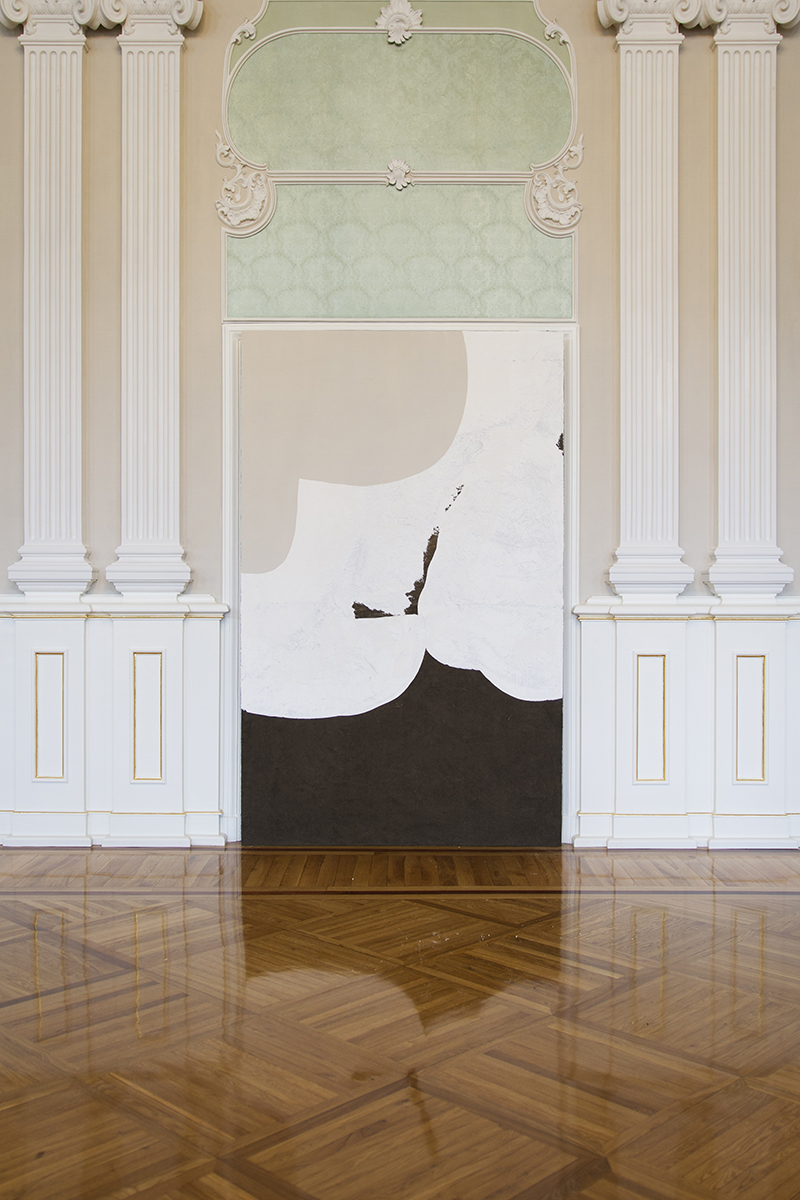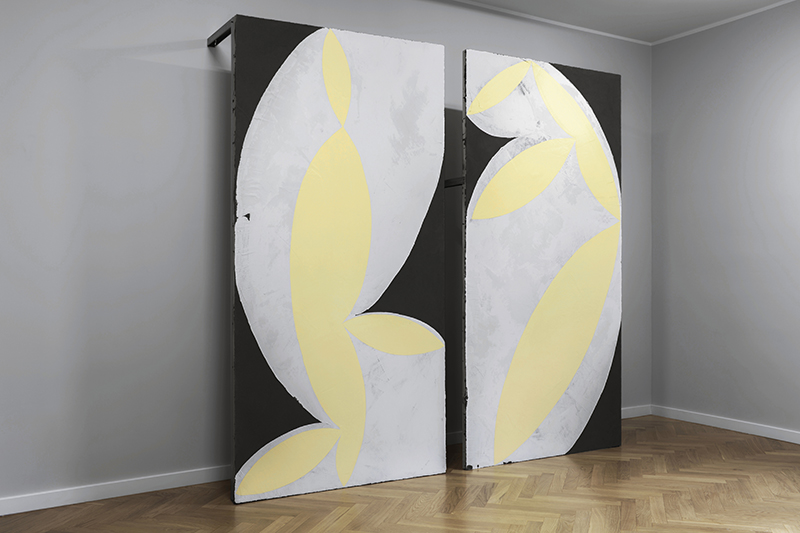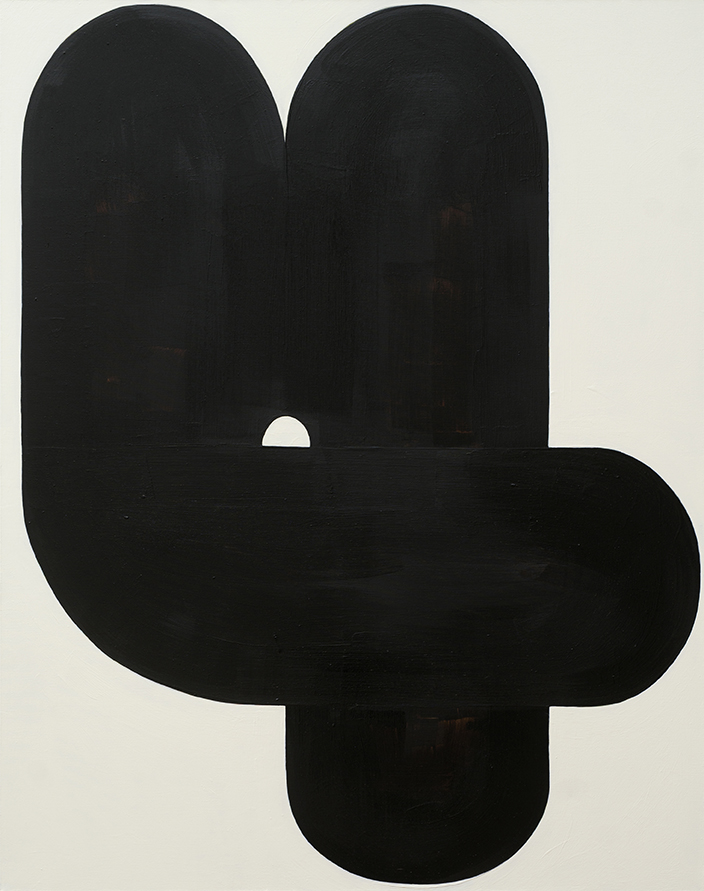Contemporary artist Karolina Bielawska wants her conceptual works to extend an overpowering effect on the space, and subsequently, on the viewer.
There are viewers who feel the strong impact of my pieces on the place – some of the works are so intense that they seem to take over the space.
Contemporary artist Karolina Bielawska
Featured image: Marrow. 2019.
Special thanks to Ewa Borysiewicz.

Balans. Contemporary artist Karolina Bielawska. 2019.
My installations suggest close proximity to architecture; they might double an existing wall, move it, break it or shatter it – just to be reconstructed as second skin. It is typical for me to work with the history and context of a place.
How do you describe yourself in the context of challenging people’s perspectives via your work and art?
My painting does not bombard viewers with an overload of stimuli or easy, narrative figuration. It is rather focused and disciplined. The formal values that gradually reveal themselves to the eye are firmly embedded in the properties of the materials I use: their industrial origin, textures, density, and colours. I often create site-specific works through carefully planning their relation to space. My installations suggest close proximity to architecture; they might double an existing wall, move it, break it or shatter it – just to be reconstructed as second skin. It is typical for me to work with the history and context of a place. I also focus on the potency of emotions resonating between painting and the viewer.

Kompleks. Contemporary artist Karolina Bielawska. 2017.
They constitute things and events themselves, they are the heroes of their own narration depicted in matter, colour, shape, and scale. My decisions are concrete, although the material I operate with, is often dense and resistant – bitumen, plasterboards, OSB and putty.
Tell us about the evolution of your practice over the years. What would you call your style?
I may go beyond traditional formats and painting techniques, but I don’t completely break off the relationship between my work and painting, understood as a collection of specific visual qualities. Whether they are paintings on canvas, or post-painterly installations, they are not intended to represent things and events. They constitute things and events themselves, they are the heroes of their own narration depicted in matter, colour, shape, and scale. My decisions are concrete, although the material I operate with, is often dense and resistant – bitumen, plasterboards, OSB and putty.

The Other Room. Contemporary artist Karolina Bielawska. 2019.
How does your audience interact and react to the work you put out into the world?
People familiar with my works and visitors to my exhibitions used to say that despite its discipline and meditative meticulousness, my practice is capable of generating an explosion of diverse and multilayered reactions. There are viewers who feel the strong impact of my pieces on the place – some of the works are so intense that they seem to take over the space.
The shapes and compositions created by me are much appreciated. My audience usually consists of attentive viewers who admire my paintings for evoking various connotations like harmony, balance, intimacy, connection, calm but also force, strength, intentness, movement, and astonishment. Despite simple geometric stains of varying proportions, they are often described as poetic and subtle.

Ties. Contemporary artist Karolina Bielawska. 2019.
What were you working on when the lockdown was announced?
I was in the middle of moving to the new studio and making sketches for new paintings.

Dryf. Contemporary artist Karolina Bielawska. 2017.
How are you balancing life and work at home during this period? How has this affected your practice and plans?
As my daily routine consists of hours spent alone at the studio, I got used to isolation. After the lockdown was announced, I left Warsaw. At the moment I’m spending most of my time with family, in my hometown Masuria – a unique region in northeastern Poland, with a multitude of lakes, waterways and a verdant forest. I feel good here.
What would elevate artists’ life during this period?
I am asking myself the same question and actually, I don’t know. I am tired of online events and virtual projects.

Motion Commotion. Contemporary artist Karolina Bielawska. 2019.
How do you strike a balance between the contradicting motivations – commercial v/s creative? How does your interaction with a curator, gallery or client evolve from the initial interface to a working-relationship?
The idea always comes foremost. When I share it with the curator, gallery or client, we can start to cooperate. We have to begin with a similar point of view to build a stronger relationship, and then we can try to create a conscious and valuable message. The art world is a huge network, wherein all its elements and parts are interconnected – we are dependent on one another and we learn from one another.

Well. Contemporary artist Karolina Bielawska. 2019.
What was your first sale? Do you handle the commercials yourself or is it outsourced to a gallery/agent.
I sold my first work when I was a student. I still handle selling and all commercially related matters by myself, but at the moment there are many more partners interested in my work and open for collaboration. I cooperate with several galleries and art advisors.

Sisters. Contemporary artist Karolina Bielawska, 2019.
When I am finally in there, I’ll spend hours thinking, reading, drawing, measuring, composing and painting.
Tell us about your studio, what kind of place is it? Could you describe your usual workday in the studio?
I was lucky to have a studio in a great industrial space in Warsaw. It was an amazing building, one of the biggest printing houses in Poland, built and operative during communism. Today the building is closed, waiting for demolition. I am moving now to new studio – it is in old XIX-century palace in the very heart of the city. The building was destroyed during The Second World War and then rebuilt after. I share a floor with two galleries. I hope to start my work soon, when the renovations are done and everything is ready. When I am finally in there, I’ll spend hours thinking, reading, drawing, measuring, composing and painting.
Are you more of a studio artist or naturally collaborative by nature?
My art takes time. It begins with finding a starting point and ends with working in the studio. Conceptual work and observation form a big part of this creative process.

Marrow. Contemporary artist Karolina Bielawska, 2019.
Is there any topic you would like to be mentored on?
I am currently working on a bunker topic. Bunker is a characteristic kind of architecture, an ideal form of isolation against external threats. I study its historic background and modern technologies. I am interested in bunkers’ functionality combined with a rather oppressive construction and strict aesthetics, which are not conducive to a sense of security. I would like to take part in a project that undertakes the problem of the impact of a specific space on the human psyche.
Special thanks to Ewa Borysiewicz.
Before you go – you might like to browse our Artist Interviews. Interviews of artists and outliers on how to be an artist. Contemporary artists on the source of their creative inspiration.











Add Comment